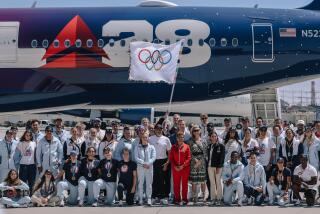Ride Goals Not Met by County : Commuting: A survey shows that government workers did not fulfill new rules aimed at reducing air pollution.
In the first test of new Ventura County rules to reduce automobile exhaust, the county government has failed to encourage enough solo commuters to share rides, take the bus or find other ways to work at county offices, a survey shows.
The results of an employee survey released Wednesday showed that the county fell slightly short of the air pollution rules that require an average of 1.35 people for each vehicle coming to work, or about four people for every three cars.
County officials say they are not discouraged that they did not satisfy all the requirements, which will be extended to all employers with 50 or more workers in Ventura County over the next 18 months.
“I don’t think it is a sign of failure,” said Angela Dukes of the county’s Air Pollution Control District. “It just means that we need to keep trying.”
But private businesses question how county officials can demand results from them that they haven’t achieved themselves. “It puts them in a compromised position, that’s for sure,” said Ernest Becker, director of human resources at Textron Filtration Systems of Newbury Park.
Textron is one of the scores of businesses and public agencies required to submit detailed plans on how they will persuade one in four workers to car-pool, take a bus, ride a bike, jog or walk to work.
The trip-reduction plans are part of the county’s strategy to cut exhaust from cars and trucks, which contribute about half of the pollutants that form smog in the county. Ventura County, like Los Angeles County, faces state and federal mandates to lower smog levels that at times exceed air pollution standards.
Officials at the county’s Air Pollution Control District, which enforces the new trip-reduction rules, said they will not fine any employer for failing to meet the quotas as long as the employer is making a good-faith effort.
A year before requiring others to participate, the county decided to ask its own employees to reduce by about one-fourth the single-occupancy vehicles that make the morning commute between 6 and 10 a.m.
A weeklong survey of 5,532 county employees taken in mid-April showed an average of 1.29 employees per vehicle, less than the 1.35 average required under the law, said Jim Pickens, transportation coordinator for county employees.
Not all of those employees work at offices covered by the anti-smog rules. Only eight of the county’s largest work sites must meet the trip-reduction quotas designed to help clean up the county’s dirty air. Of those eight sites, six failed to meet the legal requirements.
But Pickens said he was encouraged that employees at two job sites exceeded the requirements: The Public Social Services Agency building behind Ventura City Hall on Poli Street averaged 1.37 employees per vehicle, and the county’s road repair and vehicle maintenance yard on El Rio Drive in Oxnard averaged 1.54 employees per vehicle.
Both of these job sites have compressed the workweek for employees to four, 10-hour days, to eliminate one-fifth of employee commuter trips, he said. The compressed workweek is handled in staggered shifts, so the offices do not close their doors one day a week, as the Thousand Oaks City Council has recommended for its City Hall.
The Ventura County Government Center, the largest county facility with 2,600 morning commuters, averaged 1.3 workers per vehicle, a substantial increase from the ride-sharing and alternate transportation use of a year earlier but still short of the legal requirement.
“I don’t think those numbers are too bad,” Pickens said. “When we started, we had to lose 800 cars out of our parking lot, or 800 trips a week. Now, we have to reduce less than 200 cars. That is a major jump.”
Employees at other county workplaces also demonstrated encouraging increases in sharing rides or taking public transportation, he said. The 234 employees at the Camarillo Airport failed to reach the legal requirement because just one car too many arrived in its parking lot during the week of the survey, he said.
To encourage employees to participate, the county offers a $200 annual bonus to those employees who share rides twice a week and $300 for those who do so three times a week. In addition, the county gives preferential parking for car pools and provides showers and lockers for those who ride a bicycle or jog to work.
Pickens said a special committee will review the survey results to determine if the county needs to provide additional incentives or other measures to reach its goals.
“I wouldn’t be surprised if we all have trouble meeting the quotas initially,” said Marshall C. Milligan, president of Bank of A. Levy in Ventura, which is formulating its own trip-reduction plan. “If the county is struggling with it, that indicates to me that we are going to struggle with it too.”
More to Read
Sign up for Essential California
The most important California stories and recommendations in your inbox every morning.
You may occasionally receive promotional content from the Los Angeles Times.









